物流与供应链管理【英文】
物流与供应链管理 Logistics and Supply Chain 英语介绍
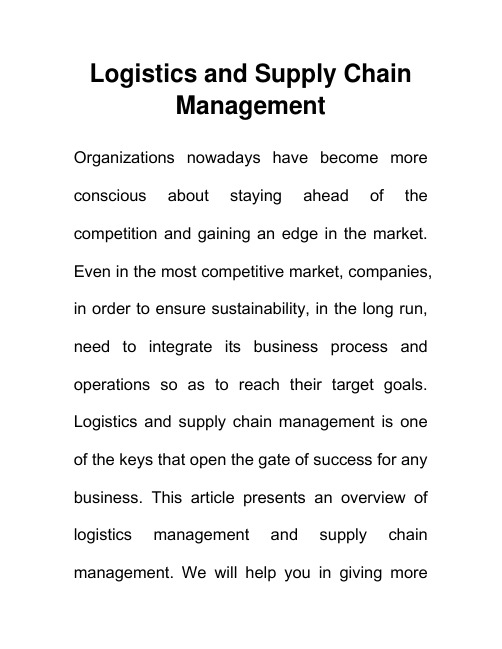
Logistics and Supply ChainManagement Organizations nowadays have become more conscious about staying ahead of the competition and gaining an edge in the market. Even in the most competitive market, companies, in order to ensure sustainability, in the long run, need to integrate its business process and operations so as to reach their target goals. Logistics and supply chain management is one of the keys that open the gate of success for any business. This article presents an overview of logistics management and supply chain management. We will help you in giving moredetails on Logistics and Supply Chain Management.Logistics and supply change management is used by the organizations to plan and control the activities and operations as well as coordinate amid the companies either in the same or adjacent industries. Though both these terms at times are used interchangeably, however, the supply chain management is an overall concept that connects the numerous processes of an organization to attain competitive advantages in the industry.On the other hand, logistic is the movement as well as the flow of products, services together with information within the supply chain. The logistics focus on the activities of the same company whereas the supply chain has widened focus due to the involvement of multiple enterprises such as manufacturers, suppliers as well as retailers.Logistics ManagementThe logistics work primarily for the requirement of the customers while supply chain management aims towards attaining competitive advantage for an organization. Therefore, it canbe said that logistic management is a crucial element of supply chain management. It enhances the aspects of the strategy, planning as well as implementation, thereby reducing the cost to provide maximum satisfaction to the customers.The role of logistics and supply chain management is to ensure that the product is delivered to the right customer at the right price as well as at the right time without any discrepancy or delay. Besides this, it involves activities such as transportation, warehousing,controlling stock and monitoring the inflow and outflow of goods from the organization.Supply Chain ManagementSupply chain engages activities such as operations and procurements which are necessary for efficient and effective running of business. It plays a vital role in the success of the company as it aims to accomplish the needs and demands, driving outstanding values from customers, enhancing the responsiveness of organization, building network resiliency and facilitating financial success.Thus, logistic management is an important part of the supply chain management as it involves carrying out of management in addition to information from the point of origin to the consumption-point.Planning and Controlling ActivitiesPlanning and controlling activities are among the most important functions of logistics and supply chain management.Activities and objectives are created under planning and implementing the same effectively under control. These two paradigms works forreconciliations between what is needed by the market and what can actually be delivered by the operation resources.Supply chain management involves the process that helps in the movement of the raw material from the beginning of the production till the deliverance of the goods to the end users. It has been found that in various companies, operational supply chain decisions are made more than a number of times affecting how products could be manufactured or developed, moved as well as sold.In an attempt to meet the challenges in delivering the goods to customers, companies have adopted automated logistics and supply chain management processes for efficient and significant impact on bottom lines.In order to attain a better profit margin, there are a few other important benefits of adopting an appropriate logistics and supply chain management technique or strategy, both into the factory, the warehouse and distribution channels. The intricacies of the supply chain vary with the business along with the obscurity and the quality of items being produced.Functioning of the Logistics and Supply ChainIt is the customers who start the chain of events while they make purchase decisions that have been offered by any company for sale. Logistics and supply chain management system not only enhances the service quality but also amplify productivity through the extraction of wastes.One of the most important things in the logistics and supply chain management process is to ensure that each activity adds value for the end users. If the product needs to be produced, the sales orders must include a prerequisite that is required to be fulfilled with the use of productionfunction. We will provide you proper guidance on Logistics and Supply Chain Management.PlanningThe planning department makes a production plan that includes the manufacturing details of the product in accordance with the demand of the customer and their orders. To manufacture the products the company then purchases the raw material.The planning department works at the administrative level of the organization. This department refers the project team who createthe master plan as well as sector plan along with many other planning efforts that works as the guiding information for the organization to help regulate those plans.PurchasingThe purchasing department receives a list of raw materials and services required by the production department to complete the customer’s orders. The purchasing process is considered crucial as it works as a tool to identify the requirements of the customers, evaluate the needs efficiently, identify thesuppliers, make sure payment occurs effectively and drive improvement continuously.The raw material is received from the suppliers; it is then checked for quality and accuracy and later moved into the warehouse.Inventory ManagementThe inventory management is important because it resists stock-outs, handle multiple locations and ensure appropriate accounting. Inventory is a term related to the stocking of the materials and represents those various levels from raw material to finished products. Based onthe production plan, the raw materials are moved to the production area.These raw materials are used to manufacture the finished product and then sent to the warehouse and stocked for shipping. Implementing a lean logistics and supply chain management in the production process is a key element that helps in developing long-term value and relationship with customers as well as increasing the overall organizational performance.ProductionThe production department in a company is responsible to handle a group of activities that involves the manufacturing process of the goods. This department is the largest group within the organization. It is responsible for transforming input into the final output using a set of the process needed for production.The production manager is responsible for ensuring that the raw material is obtained and transformed into finished good in an efficient way. From there the finished good is sent to the warehouse. The warehouse is considered as the key function as well as a destination in theoverall planning and implementation of supply chain management. It aims to receive and distribute the goods or materials. For many companies, it is concerned as a strategic function.PackagingOn the other hand, the packaging is also a key function in logistics and supply chain management. It is used for protecting finished good from damaging and allows for effective distribution of the products to the appropriate customers. It plays the role of product prompteras it communicates to the customers the information with regard to the goods.For a successful logistics and supply chain management, the packaging system is required to be connected with the activities of marketing, production as well as logistics. As soon as the finished products arrive in the warehouse, then the shipping department settles on the most competent methods to deliver the products to the right customers before or on the date as specified.This is the overall functioning of the logistics and supply chain management. It requires a lot ofefforts from the organization’s end to maintain a balance between the supply and demand of any product or service.A number of companies have segmented their logistics management streamlined it with the supply chain so as to enhance customer relationship together with lowering down their huge operational costs which might otherwise create a burden on the management. Both logistics and supply chain management are interlinked and so, it will not be wrong saying that one process cannot exist devoid of the other.We will now explain you about Inbound and Outbound Logistics.Inbound and Outbound LogisticsLogistics and Supply Chain Management enhances various activities such as inventory handling, as well as the packaging process of the products, transportation, and warehousing, delivery to the customers.There is no doubt that the smooth functioning of the organizations depends on the efficient management of supply and demand which in turn have a significant impact the overall imageand reputation of the organization in the eyes of the customers. In this era of globalization, the Logistics and Supply Change Management has become the most important tool to gain the competitive advantage of global market opportunities.Inbound operationsThe managers of inbound logistics as well as of outbound logistics play a vital role in the Logistics and Supply Chain Management. The inflow of the resources that a company needs to produce its products or render services is managed by the inbound logistics managers.They are responsible for building a relationship among the suppliers as well as retailers.Besides this they manage activities that are necessary for the manufacturing of products such as accessing raw materials, negotiating the price of materials and arranging fast delivery of the products that customers have ordered whereas the manager of outbound logistics deals with two issues including transportation and storage of the goods. They are responsible to implement the cost-saving strategies for the company along with maintaining the orders of the customers.Outbound operationsTo ensure that the good that is produced remains impeccable and safe to use, these managers use warehousing technique. The products may need to be transported as per the imminent demand of the customers and this makes the transportation a critical point which is affected by a number of factors such as a change in the price of fuel or delay delivery. So the outbound logistics manager needs to deal with factors that lead to proper transportation of the ordered products.The traditional organization used to treat them separately but at present, there is a certain value added functionalities associated with them due to their interdependency. In simple words, it is said that the Logistics and Supply Change Management helps in facilitating the manufacturing and marketing operations in an organization.Challenges in the Logistics and Supply Change ManagementAt present, in all the organization Logistics and Supply Change Management plays a vital role in the smooth working and success of a company.It represents various management functions in the organization. Either big companies or small firms all have somehow ort the other adopted effective Supply Chain Management techniques so as to meet their target objectives. However, in the era of globalization, almost all companies all around the world face some challenges in their management system.Though appropriate Logistics and Supply Chain Management provides the companies, especially manufacturing units’ competitive advantage as well as a business advantage;however, there are challenges too in the way of implementation of the system.Due to the increase in the market competition, the Logistics and Supply Chain Management System is facing an increasing number of challenges in the way of creating and running the management system efficiently and effectively. Globalization, consumers changing preferences, market growth, extreme work stress, growing demand of customers are among the major challenges the organizations face in the smooth running of the logistics management.Processing Enormous Amount of Data and InformationProduction of goods goes in a long process and managers are required to maintain a large amount of the details on daily basis. Due to globalization, the information about the suppliers as well as customers from the different location needs to be recorded appropriately and accurately.The managers’ needs to ensure the details about raw materials provided; security of the good, packaging, warehousing, shipment, labor agreement, taxes and pricing of the materialsand many others work’s details. These involve process that are not only complex but also time consuming which as a result leads to the distractions and stress.The long process sometimes also becomes tedious that diverts the mind of the managers from ensuring accuracy of the details.Details with regard to raw materials that need to be obtained from the retailers, suppliers as well as partners even including the customers are in both structures as well as in unstructured format which makes it difficult for the managers to identify, evaluate and produce information fromsuch disorganized pieces of detail. This makes Logistics and Supply Chain Management more complex.Manpower ManagementManpower management is one of the main hidden responsibilities of the managers in the organizations. It is one of the toughest tasks for the inbound logistic managers. They are responsible to maintain human approach and relationship among the workforce and simultaneously with aim to attain more success.Well! it is not as simple as it sounds, rather it worsens the work environment when the employees or staffs at remote locations are not managed appropriately.Offering Segmented,Customized ServicesThe logistics management involves the activities such as packaging of goods in a proper and attractive way and transportation of good to the right customer as per their demand.The organization needs to ensure that it must meet the demand of the local as well international standard of manufacturing,handling, and packaging as well as shipping of the products. Besides this, we have also heard about the changing trends in customers taste and preference. That too creates a burden on the big organization to deal with these demands.The organizations are continuously trying their best to fulfill the necessity of the customer and providing them maximum satisfaction but this is not as easy to do as to hear. Company has to keep enhancing the features and update itself with the new technologies for manufacturing and delivering the goods and render services associated with it according to the preferencesof the customers. Again a complex situation arises for the managers while ensuring appropriate implementation of logistics and supply chain management.Cutting Transportation CostIt is for sure that companies try to deliver the orders placed by the customers on time or before the expected time. Nevertheless transporting the goods to the customers living in the different geographical location is not easy for the company as it involves the various factors, particularly the escalation in freight charges or even a minor increase in the price of fuel. This isanother challenge for companies in the adoption of cost effective logistics and supply chain management.Besides this, companies also face major threat while handling their cost control protocol. Increase in the operating cost also causes extreme pressure on the financial managers as they have to update themselves with new technologies, deal with the increasing labor wages for the global rate production as well as with the increasing commodity prices. The managements often face problems in cost saving for the organization.ConclusionGetting enormous advantages from the logistics and supply chain management is the desire of every company as it involves huge investments so that they can reap the benefits. It is also true that each stage of the supply chain delivers food from the origin (farm) to your dinner table. Supply chains combine integrated logistics, product innovation strategy, and production approach along with forecasting demand. Besides this, the process that is followed in the supply chain management will put the manufacturers and dealers in a great positionthat enables them, to foresee or predict demand in addition to making their moves or planning their strategies accordingly.Moreover, when the business is competent to pool resources better or capable of streamlining the whole production as well as distribution processes, it directly improves the bottom line along with enhancing the productivity and the overall output. Thus, the entrepreneurs and the managers along with the entire team can stay ahead of the competition and enjoy greater profits as well.Therefore, it is essential that companies should understand the implication and importance of a well-organized logistics and supply chain management as well as hire managers to streamline the process that enables the organization to attain productive results.。
物流专业英语1——物流与供应链
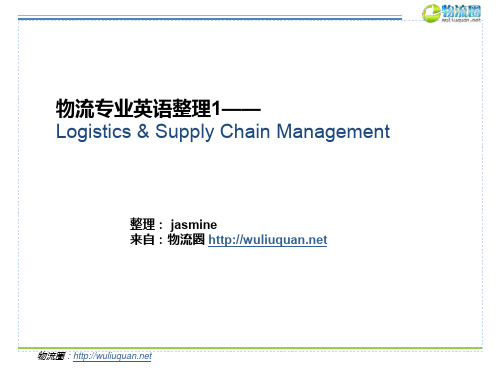
3
资料来源:《物流专业英语》
1. Logistics
The scope of logistics Logistics covers a variety of functions which include, but are not limited to, the following:
Logistics mainly focuses on procurement and distribution of physical goods. However, it is also linked with production. The key issue is to decide how and when raw materials, semifinished and finished goods should be acquired, moved and stored. The seven rights
原材料 半成品 产品 价值链 供应商 承运商 配送中心 零售商 装配 仓储 库存跟踪 库存管理 客户服务 物流成本 订单管理 渠道分销 配送 递送 生产调度 订单处理 搬运装卸 流通加工 需求预测 选址 仓库布局 车辆调度 拣选 raw materials semi-finished goods finished Product value-chain supplier carrier distribution center retailer assembly warehousing inventory tracking inventory management customer service logistics cost order management channel distribution distribution delivery production scheduling order processing handling, loading and unloading distribution and processing demand forecasting site selection warehouse layout vehicle scheduling order picking 垂直整合 vertical integration 横向整合 horizontal integration 供应链模型 supply chain model 大规模生产 mass production 定制产品 customized product 员工授权 employee empowerment 决策支持系统 decision Support System 快速响应 quick response(QR) 信息共享 information sharing 通用产品编码 Universal Product Code(UPC) 电子数据交换 Electronic Data Interchange(EDI) 销售点 Point of sale(POS) 高效客户响应 Efficient Consumer Response(ECR) 连续库存补充计划 Continuous Replenishment Program(CRP) 库存周转 Inventory Turn 需求配送规划 Distribution Requirements Planning(DRP) 配送资源计划 Distribution Resource Planning(DRP II) 供应商管理库存 vendor managed inventory(VMI) 供应链作业参考模型 Supply chain operations reference model(SCOR) 整合信息系统 Integrated information system 电子商务 Electronic commerce 协同管理 coordinated management 实物分销 physical distribution 集货 freight consolidation 逆向物流 reverse logistics
供应链专业英语词汇总结
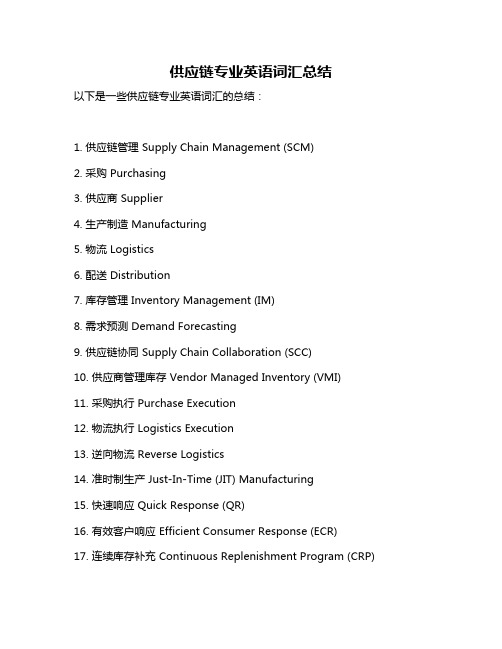
供应链专业英语词汇总结以下是一些供应链专业英语词汇的总结:1. 供应链管理 Supply Chain Management (SCM)2. 采购 Purchasing3. 供应商 Supplier4. 生产制造 Manufacturing5. 物流 Logistics6. 配送 Distribution7. 库存管理 Inventory Management (IM)8. 需求预测 Demand Forecasting9. 供应链协同 Supply Chain Collaboration (SCC)10. 供应商管理库存 Vendor Managed Inventory (VMI)11. 采购执行 Purchase Execution12. 物流执行 Logistics Execution13. 逆向物流 Reverse Logistics14. 准时制生产 Just-In-Time (JIT) Manufacturing15. 快速响应 Quick Response (QR)16. 有效客户响应 Efficient Consumer Response (ECR)17. 连续库存补充 Continuous Replenishment Program (CRP)18. 电子数据交换 Electronic Data Interchange (EDI)19. 全球定位系统 Global Positioning System (GPS)20. 射频识别技术 Radio Frequency Identification (RFID)21. 自动化仓库 Automated Warehouse22. 高级计划与排程 Advanced Planning and Scheduling (APS)23. 企业资源规划 Enterprise Resource Planning (ERP)24. 客户关系管理 Customer Relationship Management (CRM)25. 电子采购 e-Procurement26. 供应链风险管理 Supply Chain Risk Management (SCRM)27. 精益供应链管理 Lean Supply Chain Management (LSCM)28. 环境可持续供应链管理 Environmentally Sustainable Supply Chain Management (ESSCM)29. 社会可持续供应链管理 Socially Sustainable Supply Chain Management (SSSCM)30. 可持续供应链管理 Sustainable Supply Chain Management (SSCM)31. 供应商评价 Supplier Evaluation32. 采购谈判 Purchasing Negotiation33. 供应链绩效评估 Supply Chain Performance Evaluation (SCPE)34. 总成本分析 Total Cost Analysis (TCA)35. 总持有成本 Total Cost of Ownership (TCO)36. 经济订货量模型 Economic Order Quantity Model (EOQ)37. 安全库存 Safety Stock38. 采购周期 Purchasing Cycle39. 供应链网络 Supply Chain Network40. 多供应商 Multi-supplier41. 多配送中心 Multi-distribution Center42. 库存周转率 Inventory Turnover Rate43. 在途库存 In-transit Inventory44. 在途货物 In-transit Cargo45. 在途车辆 In-transit Vehicle46. 在途订单 In-transit Order47. 在途发票 In-transit Invoice。
MIT的物流与供应链管理(英文PPT79页)
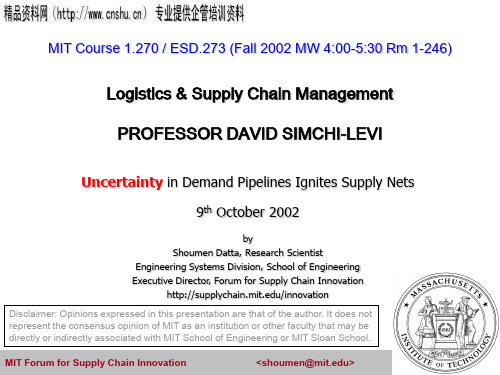
Manufacturer
PERSONAL PROFILE
SOFTWARE
MIT Forum for Supply Chain Innovation
<shoumen@>
Source: AMR Research 1999 October
20
15 10
Cห้องสมุดไป่ตู้M $ billion
1997
1999
MIT Forum for Supply Chain Innovation
<shoumen@>
Today’s discussion
UNCERTAINTY
SCM is managing uncertainty.
URL for powerpoint presentation /innovation
Education Course 1.270 / ESD.273
MIT Forum for Supply Chain Innovation
<shoumen@>
Nobel Prize in Economics 2002
(announced today, 09 Oct 2002)
"for having integrated insights from psychological research into economic science, especially concerning human judgment and decision-making under uncertainty"
MIT Course 1.270 / ESD.273 (Fall 2002 MW 4:00-5:30 Rm 1-246)
物流与供应链管理Logistics and supply chain management
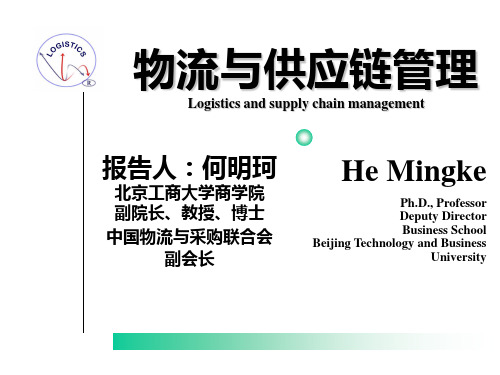
传统的商业模式
Traditional business model
$100,000,000 $80,000,000 $60,000,000 $40,000,000 $20,000,000 $0 1 ($20,000,000) 2 3 4 5 6 7 8 9 10 11 12
预测
制造 采购
经营 风险
供应链物流的需求
Logistics Requirements of Supply Chain
1.供应链的快速响应(Quick Response) 2.延迟制造导致供应链重心下移:B2C配送
3.零售商管理库存转向供应商管理库存(VMI)
4.降低供应链成本(Activity-Based Costing, DPP) 5.客户关系管理(CRM) 6.流程重组(Procedure Re-engineering, ERP,DRP) 7.持续补货策略(CRP)
传统储运与现代物流的区别 供应链管理及其策略
对企业发展物流的建议
Suggestions on the development of logistics in China
观念要先行,规划要配套,投资要慎重
鼓励多种治理方式的竞争(1→2 → 3 → m)
鼓励厂商开展第三方物流业务
完善第三方物流发展所需的环境
一个工厂直送少数门店群 From one factory to few outlets directly A
多个工厂直送多个同样的 门店群 From several factories to same multiple outlets directly B
多个工厂通过配送中心送给多个同 样的门店群 From several factories to same multiple outlets via distribution centre C
《物流与供应链管理》课程简介
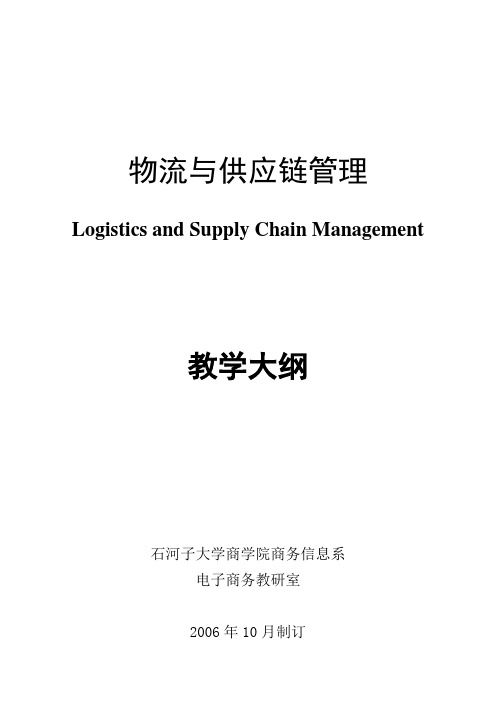
物流与供应链管理Logistics and Supply Chain Management教学大纲石河子大学商学院商务信息系电子商务教研室2006年10月制订《物流与供应链管理》课程教学大纲英文名称:Logistics and Supply Chain Management课程代码:一、课程说明1.课程性质:专业必修2.课程的目的和任务:本课程要求学生了解现代物流与供应链管理的概念及产生和发展的过程、供应链的构建、供应链管理的主要内容、供应链管理方法、企业物流战略及其组织、业务流程再造。
理解和掌握企业供应物流管理、销售物流管理、及运输管理、库存管理、包装及物料的搬运等理论知识,掌握物流的功能及作用、现代物流运输技术与管理、库存管理、仓库及配送中心业务管理等实务。
通过本课程的学习,使学生对有关的物流管理基本理论及相关知识进行学习和掌握的同时又扩充了专业知识面,增强学生的专业意识和专业洞察力,提高学生的专业素质和专业品质。
3.适用专业:电子商务4.学时与学分:54学时,3学分5.先修课程:管理学6.推荐教材或参考书目:推荐教材名称:《供应链与企业物流管理》,兰洪杰、施先亮、赵启兰编著,清华大学出版社,北京交通大学出版社,2004年11月第1版。
主要参考书:1)《供应链管理》,马士华,林勇著,机械工业出版社,2005年8月第2版。
2)《企业物流管理——供应链的规划、组织和控制》,Ronald H.Ballou著,王晓东,胡瑞娟等译,机械工业出版社,2004年8月第1版。
3)《电子商务物流管理》,李琪总主编,魏修建主编,重庆大学出版社,2004年8月第1版。
4)《供应链设计与管理——概念、战略与案例研究》,大卫·辛奇-利维等著,季建华,邵晓峰等译,上海远东出版社,2000年10月第1版。
5)《企业物流管理——供应链视角》,约翰·科伊尔,爱德华·巴蒂等著,文武,陈志杰,张彦等译,电子工业出版社,2003年7月第1版式。
武汉大学MBA《物流与供应链管理》教学大纲
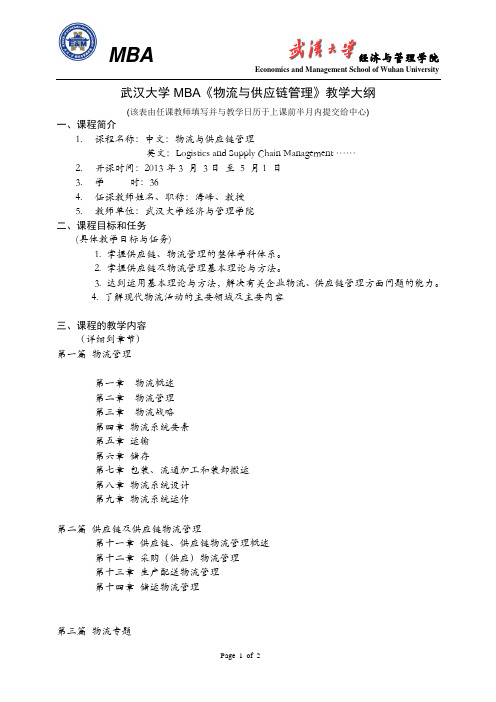
武汉大学MBA《物流与供应链管理》教学大纲(该表由任课教师填写并与教学日历于上课前半月内提交给中心)一、课程简介1.课程名称:中文:物流与供应链管理英文:Logistics and Supply Chain Management ……2.开课时间:2013年3 月3日至5 月1 日3.学时:364.任课教师姓名、职称:海峰、教授5.教师单位:武汉大学经济与管理学院二、课程目标和任务(具体教学目标与任务)1. 掌握供应链、物流管理的整体学科体系。
2. 掌握供应链及物流管理基本理论与方法。
3. 达到运用基本理论与方法,解决有关企业物流、供应链管理方面问题的能力。
4. 了解现代物流活动的主要领域及主要内容三、课程的教学内容(详细到章节)第一篇物流管理第一章物流概述第二章物流管理第三章物流战略第四章物流系统要素第五章运输第六章储存第七章包装、流通加工和装卸搬运第八章物流系统设计第九章物流系统运作第二篇供应链及供应链物流管理第十一章供应链、供应链物流管理概述第十二章采购(供应)物流管理第十三章生产配送物流管理第十四章储运物流管理第三篇物流专题物流园区专题第三方、第四方物流专题配送中心专题四、对MBA学员能力培养的基本要求(学员通过课程的学习其能力将得到何种提高)掌握供应链、物流管理的整体学科体系,掌握供应链及物流管理基本理论与方法,达到运用基本理论与方法,解决有关企业物流、供应链管理方面问题的能力,了解现代物流活动的主要领域及主要内容。
五、教学方式课程教学采用教师讲授、案例分析、专题介绍、小组讨论相结合的方法,力求使学生在理论与实际的结合上、在将实践经验上升到理论和用理论指导实践两方面有较大的收获。
课程的主要内容以面授为主,同时每次面授之后留出相当时间答疑。
案例讨论和决策模拟,最后由老师作简短的讲评。
提出若干经典著作和文选,供学员在课前、课后阅读,留给相当数量的思考题,让学员充分复习、思考和讨论。
六、课程考核方法个人作业、小组作业30%考试55%考勤15%课程考核方式课堂闭卷七、教材及主要教学参考书基本教材:海峰、胡娟主编,《物流管理学》,武汉大学出版社,2007.9,2012年再版邹辉霞,《供应链物流管理》,清华大学出版社,2011.海峰、邵校,《物流运营管理》,中国物资出版社,2012.7参考教材鲍尔索克斯等,《供应链物流管理》,机械工业出版社,2004年1月鲍新中等,《物流运营管理体系规划》,中国物资出版社,2004年1月。
物流与供应链管理(英文版)PPT课件(73页)
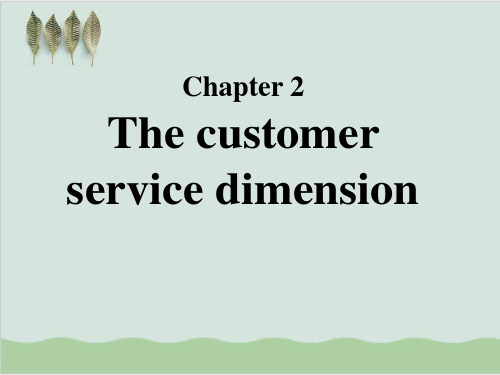
The objective should be to establish a chain of customers that links people at all levels in the organization directly or indirectly to the marketplace.
Chapter 2
The customer service dimension
Outline
The marketing and logistics interface What is customer service? Customer service and customer retention Service-driven logistics systems Setting customer service priorities Setting service standards Summary
从顾客角度出发,强调理解多重服务要素 的重要性。
Explains of the importance of customer retention and the life time value of a customer.
解释客户保持与客户终身价值的重要性。
Outlines the idea of a service-driven logistics system based upon identified service priorities and a customer based segmentation according to service requirement.
1.Pre-transaction elements
2.Transaction elements
专业英语物流和供应链管理(英文版)
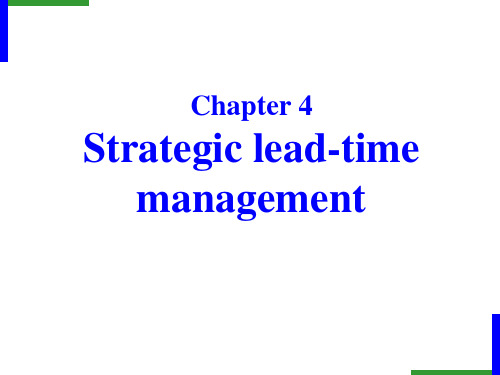
按单拣选或生产
3.Order picking or production
3 Time range
1to5days
2 Time range
1to3days
客户接受
4.transportation
运输
5.Customer receiving
2 Time range
1to3days
3 Time range
Time compression
压缩时间
完善服务
Service enhancement
缩减成本
Cost reduction
3.Volatile market making reliance on forecasts dangerous
由于市场多变,过于依赖预测很危险
Question
What’s the continuing problem for most organizations according to text?
1to5days
5 days
5 Time range
1to9days
total
15
25 days
In those situations where orders are not met from stock but may have to be manufactured, assembled or sourced from external vendors, then clearly lead times will be even further extended with the possibility of still greater variations in total order-to-delivery time.
《物流与供应链管理》读书笔记英文版

《物流与供应链管理》(LOGISTICS AND SUPPLY CHAIN MANAGEMENT)Capsule summary of the book:The world changes unpredictably, which is dependent on the quick transformation of supply chain to adapt to the variational circumstances. This book focuses tightly on those variations mentioned above, emphasizing the problems that appear when enterprises attach importance to complicated management,as well as when forecast-driven business model transforms into demand—driven business model. Also,this book elaborates how to gives enterprises dominating and competitive superiority with effective logistics and supply chain management。
Chapter1 Logistics,the supply chain and competitive strategy1。
1 Supply chain management is a wider concept than logisticsOne goal of supply chain management might be to reduce or eliminate the buffers of inventory that exist between organizations in a chain through the sharing of information on demand and current stock levels. This is the concept of ‘Co—Managed Inventory’ (CMI)。
专业英语物流与供应链管理 7
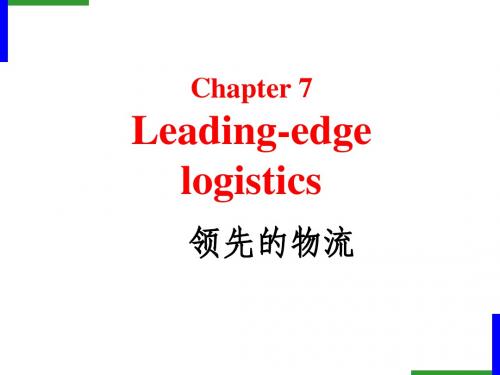
How the leading-edge companies manage logistics?
Concerning organization structure Concerning strategic posture Concerning managerial behavior
2. The new organizational paradigm 新型组织的范例
This chapter
Identifies the characteristics of companies currently believed to be at the forefront of logistics development. Reflects on the nature of the new organizational paradigm, looking at the new tools, methods and relationship management strategies being developed to enable the firm to respond to the demands of a changing environment.
(2)From profit to performance )
It is through the choice of performance measurement that behavior is determined. Performance drives profitability, If we get the right performance then profit will follow. The management meetings of the near future may begin their agenda not with the financial review but with a review of such non-financial performance indicators.
英文版物流与供应链管理
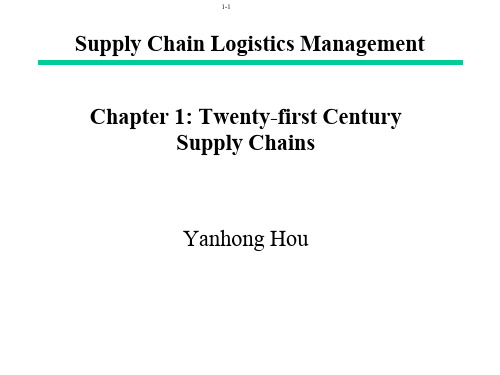
Year 1999 Transportation
1980 GDP $2.88 trillion Logistics Cost $451 billion
15.7% of GDP Trans. Cost $214 billion
2007 GDP $13.84 trillion Logistics Cost $1398billion
Center
Retailer
Customer
Support for Direct Delivery
SUPPLIER
E
M
NETWORK
A
T
E
INTEGRATED ENTERPRISE
N
DISTRIBUTIVE
D
NETWORK
C
R
Procurement
Distribution
O
I
N
A
S
L
U
S
Manufacturing
M
E
R
S
Capacity, Information, Core Competencies, Capital and Human Resources
Manufacturing Support
Procurement
Suppliers
Information Flow
1-12
Market Distribution Operating Concerns
Market Distribution:
Activities related to providing customer service. Requires performing order receipt and processing, deploying inventories, storage and handling, and outbound transportation within a supply chain. Includes the responsibility to coordinate with marketing planning in such areas as pricing, promotional support, customer service levels, delivery standards, handling return merchandise, and life-cycle support. The primary market distribution objective is to assist in revenue generation by providing strategically desired customer service levels at the lowest total cost.
企业物流与供应链管理英文

Integration can be achieved through the use of technology, such as enterprise resource planning (ERP) systems, and through collaboration and partnership among supply chain members
Secure packaging of goods to ensure safe delivery, and coordination with transportation providers for timely shipment
03
Returns and Exchanges
Management of customer returns and exchanges, including inspection of returned goods and processing of credit or replacement orders
Inventory Control
Management of stock levels to ensure availability of products while minimizing excess inventory and associated costs
Technology and Automation
Warehouse and Inventory Management
国际物流和供应链管理【英文】
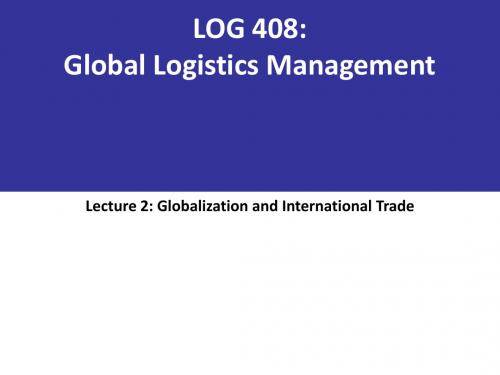
Lecture 2: Globalization and International Trade
Key Points of Last Lesson
• What Is Supply Chain: – Scope: From the raw material to the final consumer – Process: purchasing, warehousing, transportation, etc. – Objectives: cost and service level • Key Thought in Global Supply Chain Management: – Six factors makes global logistics much more important compared to a few decades ago – Highly complex, covering various aspects – SC dispersed over a larger geographical area – It offers many more opportunities than just the domestic supply chain – Risk factors are also present 2-2
$ million
8,000,000 6,000,000
4,000,000 2,000,000 0 1950 1955 1960 1965 1970 1975 1980 1985 1990 1995 2000 2004 2008 2009
Year
2-5
An observation from the US perspective
- 1、下载文档前请自行甄别文档内容的完整性,平台不提供额外的编辑、内容补充、找答案等附加服务。
- 2、"仅部分预览"的文档,不可在线预览部分如存在完整性等问题,可反馈申请退款(可完整预览的文档不适用该条件!)。
- 3、如文档侵犯您的权益,请联系客服反馈,我们会尽快为您处理(人工客服工作时间:9:00-18:30)。
Judith Molka-Danielsen j.molka-danielsen@himolde.no http://home.himolde.no/~molka
Overview
Global value model for B2B systems (all) Logistics management/supply chain (ch10) Human Resource/support services (+ch10) Customer Relations Management (ch11) Manufacturing and process management (ch12) Financial management/EDI (+ch12)
LM-SCM Distribution Management
The distribution or demand chain is concerned with: – Speeding data acquisition – Controlling inventory, warehousing and shipping – Reducing paperwork It also includes invoice auditing and order tracking
B2B Inputs
Logistics Management
Manufacturing Process Management
Support Services Financiaer Management
Logistics Management Supply Chain Management
LM-SCM
Firms are moving from an process-efficiency driven focus to a customer value-benefit focus. This involves understanding Customer Needs. Costs are coorelated to uncertainty in the Supply Chain (enterprise integration SCM software is to address this). SCM modules address: logistics, manufacturing, finance, etc.
LM-SCM Approaches
The best-in-practice approaches have been incorporated in various systems Major vendors include
– SAP – PeopleSoft – Baan
Often, organizations find adoption of full blown ERP/SCM systems require significant organizational change
LM-SCM Purchasing/Supplier Management
The goal is to simplify routine transactions and reduce paperwork Trend is to reduce supplier steering and partner with the selected suppliers so that both organizations win Purchase orders can be issued by DBMS triggers on inventory Suppliers can be allowed to replenish inventory based on agreed upon parameters
LM-SCM Fundamentals
What is a Supply Chain? Steps to meet customer needs. Global competition makes the customer in control of production, not the manufacturer. What is SC-management? Coordination of tasks (order generate, taking, filling, distribution of products, services and information). Key players create an extended enterprise. Is SCM a new concept? No, 25 years. Focus progresses: efficiency, integration of enterprise, product made to customer expectations. The last means more information integration between organizations.
Supply Chain Management (SCM) is an outgrowth of “traditional” logistics management and Enterprise Resource Planning (ERP) It extends the management function outside the organization to both the supplier organizations and the distribution channels Good ERP/SCM can increase net revenues 4-6% SCM has become an expectation for industry
LM-SCM Components
Purchasing Management
Supplier Management Requisition Management Invoice Management Inventory Management Warehouse Management
Distribution Management
